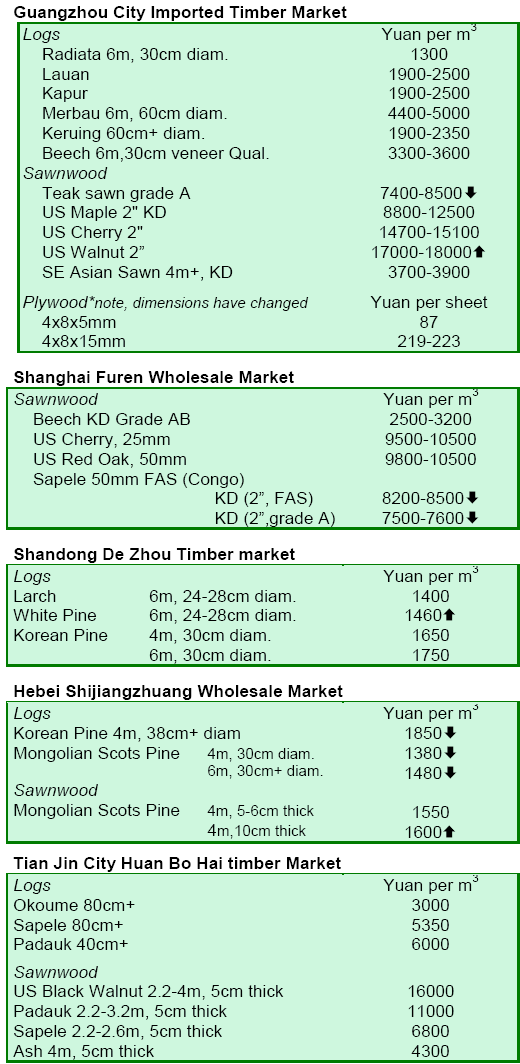US Dollar Exchange Rates of 10th October 2008
China Yuan 6.835
Report from China
Wooden door manufacturing shows growth in recent
years
The scale and output of China¡¯s wooden door
manufacturing has not been large over the past few years.
There are currently about 3000 wooden door
manufacturers in China, 2000 of which are larger
manufacturers with an annual output value of RMB5
million yuan. The annual output value of the wooden door
industry over the last few years has grown about 30%
annually and has been driven by the real estate, home
improvement and interior decoration industries.

At present, China¡¯s wooden doors are mainly sold in
domestic markets. Although sales in the international
market have been small, the export volume of wooden
doors has slowly been increasing. Wooden door
manufacturers mainly export single-leaf and nondecorative
semi-finished products. Export-oriented
wooden door manufacturers are mainly located in
Guangdong, Liaoning, Zhejiang, Fujian, Shandong,
Jiangsu, Shanghai, Jilin and Xinjiang. The main
destination for China¡¯s wooden door exports are the US
and Japan. Hong Kong, South Korea, Canada, England,
Ireland, France, United Arab Emirates and Kazakhstan
have also become popular destinations for China¡¯s wooden
doors in recent years.
China¡¯s furniture imports skyrocket in value
China¡¯s furniture imports have jumped significantly since
2000. Experts suggest that the value of China¡¯s furniture
imports will be USD1.5 billion by 2010. Prices for China¡¯s
imported furniture are three times higher than for domestic
furniture. The value of imported furniture is 5% of the
total value of China¡¯s furniture market. Table 2 below
shows the value of furniture imports from 2000 to 2007:

China¡¯s imported furniture includes bedroom, kitchen and
office furniture, redwood furniture and mattresses mainly
from Italy (24.5%), Germany (23.6%) and the US (20%).
The value of imported furniture to China from these three
countries consists of 70% of total furniture imports.
In 2005, China cut import tariffs on furniture to zero to
stimulate the growth of furniture imports. Currently,
furniture products from 30 countries have entered China¡¯s
market through franchises and domestic distributors. For
example, the US Kinwai Furniture Group, one of the US¡¯s
five major furniture enterprises, established a 400,000
hectare furniture production base in Jiangmen City
(Guangdong Province) in 1993. Since then, it has opened
nearly 700 franchised stores, with total annual sales of
RMB1 billion yuan. Experts suggest that many foreign
furniture manufacturers will enter China¡¯s market within
the next few years, especially after phase III of the
Shanghai International Furniture Village has been
completed in 2009.
Guangxi Province¡¯s forest industry boosted by
expansion of forest raw materials
Guangxi Zhuang Autonomous Region is located in a
tropical and subtropical zone in China and is one of the
country¡¯s major timber production and forest products
industry bases. The development of its forest products
industry has been greatly enhanced by the establishment of
large-scale plantations and supporting enterprises.
The Guangxi forestry bureau started two large-scale forest
and pulp and paper integration projects in Beihai City and
Qinzhou City. As part of the projects¡¯ activities, the
Chinese company Guangxi Gaofeng Forest and Pulp-
Paper Co., Ltd, which operates in conjunction with Stora
Enso and APP Timber, was formed. The Guangxi forestry
bureau has already invested RMB22 billion yuan in phase
1 of project in Beihai. After completion, 900,000 tons of
pulp and 900,000 tons of paper will be produced annually.
Currently 140,000 hectares of forest have been set aside to
supply raw materials for the company. The Guangxi
forestry sector also supports local companies such as the
Gaofeng Forest Farm, Guangxi Sanwei Forestry Industry
Co., Ltd, Wuzhou Pine Chemicals Co., Ltd, Fenglin
Forestry Development Co., Ltd, and Liujiang Paper Mill,
to promote diversity of the forest products industry.
In addition, the Guangxi wood-based panel industry has
developed rapidly in recent years. Its output reached 6.59
million m³ in 2007, 9.5 times the amount in 2000. It is
now the fourth highest ranking region in terms of woodbased
panel outputs in China.

¡¡
|